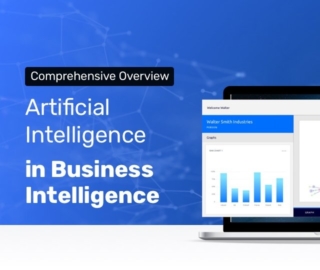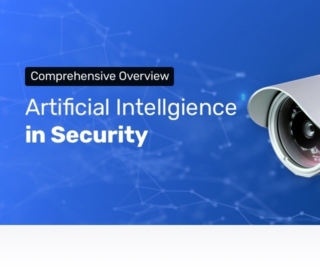
According to Deloitte, global healthcare spending is expected to grow annually by 4.1% from 2017-2021, up from just 1.3% in 2012-2016. The report suggests this growth will be fuelled by aging, rising populations, the growth of developing markets, advances in medical treatments, and rising labor costs.
Hospitals and healthcare companies will want to make more their workflows more efficient in order to meet demand. One way they could do this is with the help of business intelligence software. AI seems to be making its way into business intelligence software for the healthcare industry. As of now, numerous companies claim to assist data scientists and data analysts serving the healthcare space in aspects of their roles related to gathering insights on improving hospital environments, clinician workflows, and administrative processes.
We researched the space to better understand where AI-based business intelligence comes into play in the healthcare industry and to answer the following questions:
- What types of AI-based business intelligence applications are currently in use in healthcare?
- What tangible results have AI-based business intelligence applications driven in healthcare?
- Are there any common trends among these innovation efforts? How could these trends affect the future of healthcare?
This report covers vendors offering software across two technologies:
- Predictive analytics: machine learning-based analytics could enable hospitals and healthcare companies to make predictions on patient outcomes, diagnoses, and costs.
- Prescriptive analytics: similar to predictive analytics, but different in that the software can purportedly provide reasons for the predictions it makes.
Predictive Analytics
Cloudera
Cloudera is a San Francisco-based company that offers Enterprise Data Hub, which it claims can help providers, payers, device and drug manufacturers in the healthcare industry store and curate big data and develop predictive models that support patient care using machine learning.
Cloudera claims that the application is able to recognize and analyze data in different formats from gene sequencing, electronic health records, sensors and wearables, and clinical notes, among others, to create predictions that can help health organizations deliver better patient care and service.
For instance, a children’s hospital may need to know how environmental factors, such as light and noise, affects the quality of care and patient outcomes of infants in the neonatal ward. The hospital already collects data using bedside sensors on patient vitals, such as respiration, heart rate, and blood pressure. Aside from this, the hospital also takes hourly snapshots of the patients. The data is stored in the data hub.
Business analysts or data scientists at the hospital might then conduct a text search, such as “ambient light+infant care,” using the application’s interface. The application’s machine learning model will correlate the factor (ambient light) with the patient outcome (infant care) and search the database for patterns to show how ambient light might aggravate or improve infant conditions in the ward.
The result may come in the form of a graph that shows how fast infants exposed to ambient light in the ward might recover or deteriorate, measured in a number of days. The results would be visually presented in a graph, where recovery would mean fewer days in the hospital and deterioration or status quo would mean more in-patient days.
The health organization can then determine what action to take related to the lighting and noise that would improve the patients’ recovery.
Below is a short 2-minute video demonstrating how Cloudera works:
Cloudera claims to have helped Quest Diagnostics create a centralized data hub and implement advanced analytics. Quest is a provider of diagnostic insights to physicians and hospitals. It produces more than 750,000 lab results daily, amassing more than 20 billion lab results over the past decade. The client needed an application that could consolidate, process and analyze the unstructured and structured data sources to obtain new clinical insights.
Cloudera used its enterprise offering to combine structured data from its data warehouses with unstructured data from a variety of sources. The offering also enabled Quest to deliver new products, such as Population Lab Insights. This product enables Quest to show its clients the possible gaps in patient care and to scrutinize individual patient results to ensure they are undergoing the correct tests they need.
Quest’s data analysts and data scientists access the SQL business intelligence software and analytics using Tableau for data visualization and IBM Cognos software for BI.
Cloudera also lists GSK, Cerner Corporation, Thomson Reuters, Mastercard, the New York Stock Exchange, Komatsu, ADP, and Sikorsky as some of their past clients.
Amr Awadallah is CTO and founder at Caldera. He holds a PhD in Electrical Engineering from Stanford University. Previously, Awadallah served as VP for Engineering for Product Intelligence at Yahoo.
Enigma
Enigma is a New York-based company that offers a collection of curated public healthcare and pharmaceutical datasets, which it claims can help healthcare and life science businesses find patterns in patient safety, physician prescriptions, healthcare access, and spending using machine learning. These datasets are presented visually to give users a better view of the data.
The company adds that these datasets offer information about clinical trials, FDA regulatory reports, Medicare spending, and National Health surveys. The datasets come in a searchable web portal and application programming interface formats that could work with any business intelligence tool and integrate with any company’s internal databases.
One of the solutions that Enigma offers is the Enigma Pharmacovigilance Solution, which could help companies improve the predictive accuracy and early identification of the hazards of pharmacological drugs or what is called signals detection.
Enigma claims that this specific dataset is driven by machine-learning technologies that help data scientists and analysts identify the dangers (adverse events) of pharmaceutical products. The company did not detail how the application works but we can infer that once integrated with the clients’ internal tools and applications, users will be able to predict possible adverse events when, for instance, a company is conducting clinical testing.
The user might input a formula of a drug compound into the system. The machine learning algorithms will then search the application’s database for results of clinical trials that used that drug compound. The company claims that the application enables users to search, view, and access all internal and public data about adverse events.
Enigma does not have a demonstration video available showing how its software works.
The company does not offer a healthcare-related case study on its site but features California Data Collaborative (CaDC), as one of their past clients that used one of their datasets. The case study reports that California was faced with a severe drought, and CaDC was tasked with helping the state’s water district managers to use data to improve water reliability, efficiency, and conservation.
Since there were no standard benchmarks about the state’s water usage, CaDC used Enigma’s Concourse data operations application to centralize into one platform the water data from 411 companies that supply water to 21 million Californians. According to the case study, the application helped CaDC uncover information about how residents use water by demographic, climate, neighborhood, income, etc. It also helped them plan how to conserve and recycle water, and how water rates affect revenue.
The company does not reveal its other clients but has raised $129 million in funding from MetLife, Crosslink Capital, Capital One Growth Ventures, Two Sigma Ventures, Glynn Capital Management, New Enterprise Associates, BB&T, Comcast Venture, and Third Point Ventures.
Pratap Ranade is the Vice President, Engineering at Enigma. He holds a PhD in Applied Physics from Columbia Engineering. Previously, Ranade served as co-founder and CEO at Kimono Labs, a company that converted unstructured web data into application programming interfaces.
Tellius
Tellius is a Washington, US-based company that offers a search-based business intelligence and analytics application, which they claim can help healthcare businesses predict hospital readmissions, streamline hospital operations, and improve patient satisfaction and outcomes using natural language processing and machine learning.
Tellius claims that data analysts can input their questions in plain language on the application’s interface. The application’s NLP will then extract the meaning of the question by identifying the keywords and attempting to understand the question.
For instance, the user might ask “What were new product sales in Florida compared to Texas last week?” or “Why did sales increase in California last week?”
The algorithms then attempt to “understand: the question through the keywords and will search for information. The company explains that the results may be drawn from various sources, such as other applications, data lakes, data warehouses, and spreadsheets, among others. The machine learning technology then identifies the patterns in the data and provides responses in the form of a graph to give the user a visual perspective of the results.
According to the company, medical staff can also use the application to improve patient services while improving hospital operations. For example, medical staff aiming to reduce readmission rates could use the application to search for correlations between patients’ past admissions, treatment prescriptions, emergency room data, and doctor’s records and recommendations to discover if some patients are misdiagnosed. This could potentially translate into fewer incorrect treatments that put patients and hospitals at risk while simultaneously managing resources smartly.
Below is a short 2-minute video demonstrating how Tellius works:
Tellius does not feature any case studies nor does it list clients on its website. It has raised $9.4 million in funding from Veraz Investments.
Jason Gran was the Lead Data Scientist at Tellius, before leaving in August 2018. The company has yet to announce his replacement in the website. He holds a PhD in Physics from the University of California, Santa Barbara. The company has yet to announce his replacement in the website.
Prescriptive analytics
H2O.ai
H2O.ai is a California, US-based company that offers a namesake open-source AI and data science platform, which they claim can help healthcare businesses streamline their business to deliver better patient care using machine learning.
H2O.ai claims that the application can help hospitals and other healthcare providers predict ICU transfers, hospital-acquired infections, and hospital readmissions; improve clinical workflow; detect claims fraud; and manage clinical denials.
The machine learning model behind the software was trained on a database of patient medical records and results from clinical trials. It then uses this data in tandem with the patient’s current vital signs in order to predict how quickly the patient’s condition might deteriorate. The company also claims that the system can provide reason codes, which explain the rationale for the prediction. This helps clinicians better understand the condition of the patient and prioritize treatment.
In health insurance fraud detection, H2O’s machine learning models can be used to automate claims assessment and routing based on fraud patterns found in its database. This process alerts the team to potentially fraudulent claims and enables them to investigate further. The application also helps automatically recognize valid claims, expediting their approval and payment.
The system enables investigators to understand the AI’s reasons for labeling the claim as a fraud and streamlines the investigation. With this system, fraudsters can be potentially caught before the claims are paid, reducing costs for payers and helping keep costs down for patients.
Below is a short 3-minute video demonstrating how H2o.ai works:
H20 offers a video case study which claims to have helped Change Healthcare build accurate predictive models that derive deeper insights to improve patient care. Change Healthcare is a provider of revenue and payment cycle management, and clinical information exchange solutions.
Adam Sullivan, Senior Director of Artificial Intelligence at Change Healthcare, reports that the H2O.ai application helped the company develop predictive models that identify erroneous payments. Sullivan explains that hospitals contract Change Healthcare to discern which patient claims are best candidates for secondary review.
Using H2O.ai, the Change Healthcare team built a predictive model by creating a scoring system, where the algorithms go through its database of patient histories, diagnoses, payments and compare it with the claim being reviewed.
The company did not elaborate on the process, but we can infer that the machine learning algorithms compare the claim in review and compare it with similar cases stored in its database. The algorithms will then identify if there are erroneous parts of the claim and predict if the claim is incorrect. According to Sullivan, this model can predict erroneous payments with a 0.95% probability.
Sullivan also reports that H2O.ai was used to create a predictive model that helped its clients increase engagement with patients. The predictive model was trained to predict who among patients were at risk of knee replacement within six to nine months by comparing the patients’ medical history and prescriptions with similar cases in its database.
If the model showed the patient case to have a 62% or higher chance of surgery within the prescribed period, Change Healthcare would send a personalized message to alert the patient and recommend affordable surgical methods and treatment.
H2O.ai also lists Armada Health, Kaiser Permanente, and the Health Corporation of America, as some of their past clients.
Arno Candel is the CTO at H20.ai. He holds a PhD in Computational Physics from ETH Zurich. Previously, Candel served as senior member of the technical staff of SkyTree, a machine learning company later acquired by Infosys.
Takeaways for Business Leaders in Healthcare
Most of the companies covered in this report provide business intelligence solutions for predicting patient outcomes.
Outside of the patient-focused offerings, Cloudera and H2O.ai offer administrative applications specific to the healthcare setting, such as identifying claims frauds and erroneous payments and claims denials management. These applications help hospitals determine which claims deserve a second review and catch the fraudulent ones.
Among the companies covered in this report, Cloudera has the strongest traction due to its list of enterprise clients and its funding. The company has raised $1 billion and has built partnerships with global companies such as Accenture, Microsoft, Deloitte, Red Hat, and Tata Consultancy.
H2O.ai is the only company in this report that clarifies that its application provides reason codes that give the basis for the algorithms’ predictions. This is, in general, a difficult problem with machine learning, known as the “black box,” as we describe in our piece, The Difference Between AI and Machine Learning.
Tellius seems to have the least traction, raising a relatively low amount of funding at $9.4 million. The company is still relatively new in the business intelligence market, having been founded in 2015. Tellius might need more time to gain traction and attract more clients.
Although the companies covered in this report offer software which seem to have intuitive or user-friendly interfaces, it is likely that clients will require data science talent on their teams to manage the software and interpret the analytics they generate.
Header Image: Clear Triage







